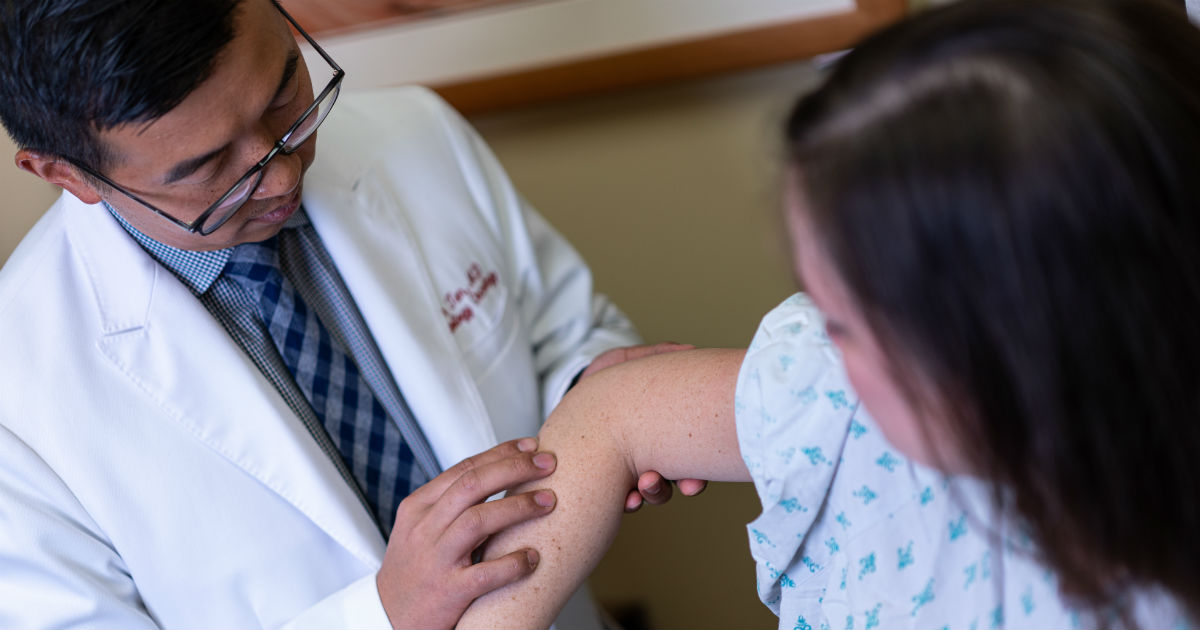
As the most common cancer in the United States, skin cancer attracts lots of media exposure, especially during the sun-kissed summer months. But here’s a fact that often escapes notice: Melanoma can surface in some of the most unusual places. Like under your toenails. Or behind your ears.
Many of us know that cancerous spots can appear in areas that get direct sun, like the face, arms and neck. But body parts that aren’t so visible, or as closely inspected, can also harbor unseen spots that may go undetected and, therefore, escape early intervention. “Under the nails is a very concerning area, especially with the common use of gel manicures,” which use a product that hardens by curing under ultraviolet lamps, says Dr. Laura Farrington, Medical Oncologist at our Chicago hospital. “The direct exposure of UV rays to the hands and nails, especially regularly, may increase the risk of melanoma and other skin cancers in those areas.”
Even the bottoms of your feet, palms of your hands and your eyelids can be vulnerable to skin cancer. Likewise, your scalp, underarms and groin may not see much of the sun, but cancer can develop there, too. Routine checkups are key to early intervention, Dr. Farrington says. “The scalp is actually a common site for melanomas,” she says. “It is also important to have regular gynecological exams, because even though the pelvic area does not have much exposure to the sun, melanoma can still occur, and it may be difficult to check yourself.”
Learn more facts about melanoma.
For hard-to-see body parts, try using a hand mirror or asking your loved ones for help. Your hairdresser can also prove instrumental in checking your scalp and behind your ears during your regular visits. If you get massages, ask your therapist to look for unusual moles, spots or patches, especially on your back. See your doctor if anything changes or looks suspicious.
Skin cancer affects people of all demographics, regardless of their skin color or pigmentation. That’s why it is important that everyone wears sunscreen, including African-Americans, who can still get melanoma, although the risk is lower. While you’re slathering on the sunscreen, remember the bottoms of your feet and hands, and take care to cover the beds of your toenails and fingernails, too. And don’t assume that tattoos will serve as sun protection. Tattoos do not protect against skin cancer. But they can hide skin cancers, so they should not be placed over moles.
To help protect yourself and your loved ones, remember these sun-safety tips:
Wear broad-spectrum sunblock with a minimum sun protection factor (SPF) of 15, and reapply every two hours, as all sunscreens deteriorate after that time. If you are swimming, reapply more often. Don’t forget your lips, eyelids, between your fingers and toes and behind your ears.
Help your kids apply and reapply the sunblock, “because even one sunburn as a child can increase the risk for skin cancer,” says Dr. Farrington.
Avoid the sun between the hours of 10 a.m. and 3 p.m., when rays are strongest.
Stay in the shade. If you have to be out in the sun during high-intensity hours, seek the cover of trees or other protective sun barriers.
Wear protective clothing such as wide-brim hats, sunglasses, long-sleeve shirts and pants.
Get yearly skin exams by a physician, especially if your family has a history of skin cancer.
Know the ABCs of skin cancer:
- Asymmetry: Half of the mole is different than the other half.
- Border: Edges are notched, uneven or blurred.
- Color: The mole is uneven in color, or has shades of brown, tan and black.
- Diameter: Diameter is greater than 6 mm, or the size of a pencil eraser.
- Elevation and evolution: The mole is raised or changes over time.
